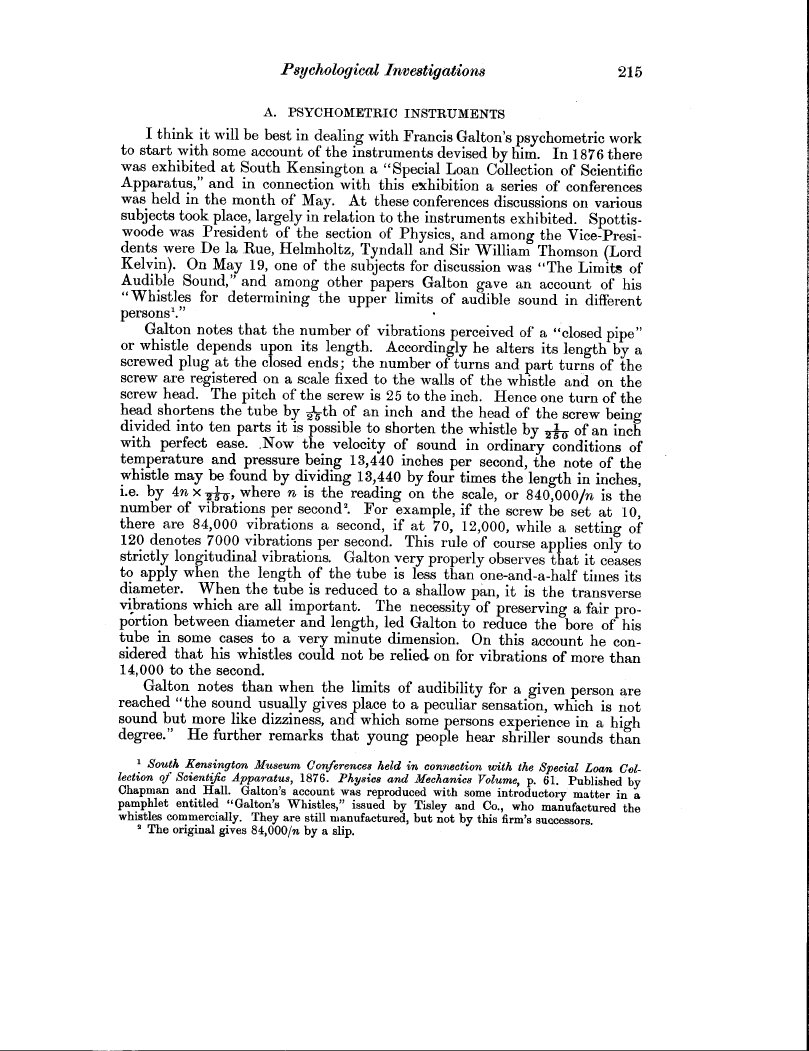Psychological Investigations 215
A. PSYCHOMETRIC INSTRUMENTS
I think it will be best in dealing with Francis Galton's psychometric work to start with some account of the instruments devised by him. In 1876 there was exhibited at South Kensington a "Special Loan Collection of Scientific Apparatus," and in connection with this exhibition a series of conferences was held in the month of May. At these conferences discussions on various subjects took place, largely in relation to the instruments exhibited. Spottiswoode was President of the section of Physics, and among the Vice-Presidents were De la Rue, Helmholtz, Tyndall and Sir William Thomson (Lord Kelvin). On May 19, one of the subjects for discussion was "The Limits. of Audible Sound," and among other papers Galton gave an account of his "Whistles for determining the upper limits of audible sound in different persons'."
Galton notes that the number of vibrations perceived of a "closed pipe" or whistle depends upon its length. Accordingly he alters its length by a screwed plug at the closed ends; the number of turns and part turns of the screw are registered on a scale fixed to the walls of the whistle and on the screw head. The pitch of the screw is 25 to the inch. Hence one turn of the head shortens the tube by 22 , th of an inch and the head of the screw being divided into ten parts it is possible to shorten the whistle by o0 of an inch with perfect ease. Now the velocity of sound in ordinary conditions of temperature and pressure being 13,440 inches per second, the note of the whistle may be found by dividing 13,440 by four times the length in inches,
i.e. by 4n x y.1-6, where n is the reading on the scale, or 840,000/n is the
number of vibrations per second. For example, if the screw be set at 10, there are 84,000 vibrations a second, if at 70, 12,000, while a setting of 120 denotes 7000 vibrations per second. This rule of course applies only to strictly longitudinal vibrations. Galton very properly observes that it ceases to apply when the length of the tube is less than one-and-a-half times its diameter. When the tube is reduced to a shallow pan, it is the transverse vibrations which are all important. The necessity of preserving a fair proportion between diameter and length, led Galton to reduce the bore of his tube in some cases to a very minute dimension. On this account he considered that his whistles could not be relied on for vibrations of more than 14,000 to the second.
Galton notes than when the limits of audibility for a given person are reached "the sound usually gives place to a peculiar sensation, which is not sound but more like dizziness, and which some persons experience in a high degree." He further remarks that young people hear shriller sounds than
1 South Kensington Museum Conferences held in connection with the Special Loan Collection of Scientific Apparatus, 1876. Physics and Mechanics Volume, p. 61. Published by Chapman and Hall. Galton's account was reproduced with some introductory matter in a pamphlet entitled "Galton's Whistles," issued by Tisley and Co., who manufactured the whistles commercially. They are still manufactured, but not by this firm's successors.
2 The original gives 84,000/n by a slip.

